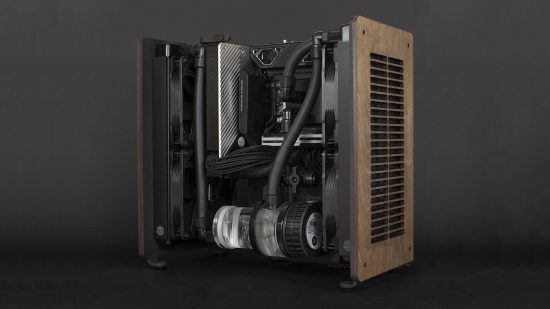At first glance, this open-air rig looks like a wood PC build, but behind the wood paneling is a custom metal chassis, which PC modder Axel Lindmarker made from scratch, before adding the gorgeous wooden panels on the sides. This mini-ITX PC doesn’t compromise on spec either, featuring a 16-core CPU, a GeForce RTX 3080 and a full water-cooling system.
Custom PC has been celebrating the best PC builds since 2003, and our Facebook group has over 300,000 members. We’ve seen many custom gaming PCs, from case mods to scratch builds. Here Axel talks us through the creation of his custom wood and metal PC case, which he calls Tilia.
My eyes were opened to the world of PC modding, water cooling and custom builds around a decade ago through a specific build by Laine over at Sweclockers. He modified a Lian Li V1000 and to me it was to die for. This was the moment when I realized that a computer could be so much more than a tool; it could be a sculpture.
Fast forward to a year ago and I was about to take the opportunity to ruin my wallet and build a once-in-a-lifetime computer with top-tier components and a custom water-cooling loop.
The last component I needed was a case that could house it all but still have a small footprint, and most importantly, it had to look like a sculpture that highlighted the components.
At that time I found no case designs with which I was happy. There were quite a few candidates but none of them stood out. Being a designer by trade, albeit not for product design, I decided that there was only one solution that would let me fulfil the life goal I set a decade ago – I was going to learn how to use CAD and design my own case.
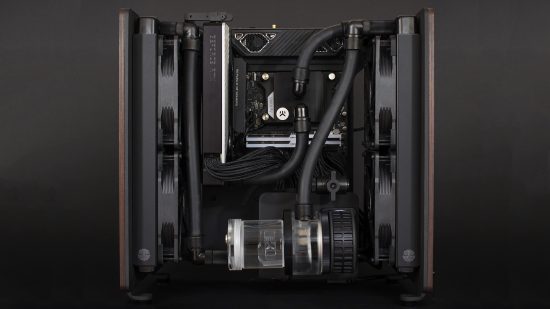
Sending out roots
Before I could get started on the design of the case, I knew I had to have some knowledge of the components that were going into the build. First and foremost, it’s designed to handle gaming at high refresh rates and high resolutions for at least a few years. In addition, it needs to be able to handle my continued use of CAD and 3D modeling for learning, plus the entire Adobe Creative suite for editing both stills and videos.
Since the build had to be a bit futureproof, I wanted to splurge on extra CPU cores, and at the time there was only really one candidate – an AMD Ryzen 9. I’m not sure if the choice of an AMD Ryzen 9 5950X was the best one, but I decided it would at least be fun to flex and get one up on a friend whose PC only had 12 cores.
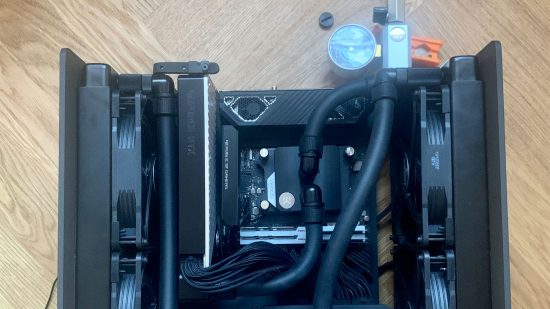
For me, the next most important feature was the graphics card. Here, I was very much debating whether I should get an Nvidia GeForce RTX 3080 or a 3090 Founders Edition with an EK waterblock, but in the end, the price difference proved too much for me to choose a 3090 (see our full guide on how to water-cool GeForce RTX 3080 Founders Edition cards with this waterblock).
Both the CPU and graphics card are slotted into an Asus ROG Crosshair VIII Impact motherboard, which I chose because I wanted two full-speed NVMe slots; to my knowledge, at the time, this was the only board of its type that included them.
The storage system comprises two 1TB Samsung 970 Evo Plus SSDs and one 2TB Samsung 860 Evo SSD, for a total capacity of 4TB. The memory comes in the form of a pair of 16GB G.Skill Trident Z 3600MHz DDR4 modules and it’s all powered by a Corsair SFX750 PSU.
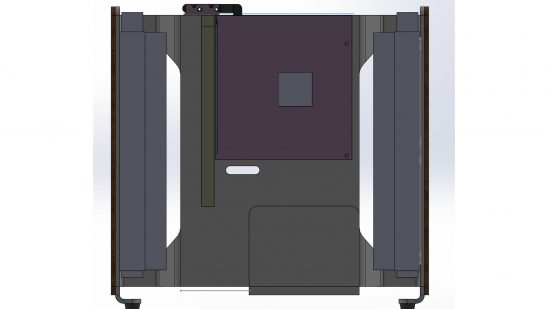
Growing strong
The design started out in 2D, with a simple layout of the components in Illustrator. This gave me an idea of the probable size and how it would look from the front. I decided from the start to be quite tactical about how I was designing Tilia.
I knew I wouldn’t be able to create a case design as intricate as an NCase M1, for example, but this limitation very much went hand in hand with my idea that this would become a sculptural piece rather than just a nice box. With this in mind, I decided that whatever I designed, it must be able to be folded from one sheet of metal.
Having designed quite a bit of packaging during my years of learning design, I was quite comfortable thinking about flat shapes and folding them up in my head. The basis for Tilia was basically designed on walks during my lunch breaks, all in my head. When I had a basic idea of the shape I wanted, I set out to make it in CAD.
To my great surprise, working with CAD was much easier than the forays I had made into 3D modeling in Cinema 4D and Blender. The ability to draw an object as a 2D shape that was later extruded made a lot more sense to me, and the ability to finally start visualizing the end result was incredible.
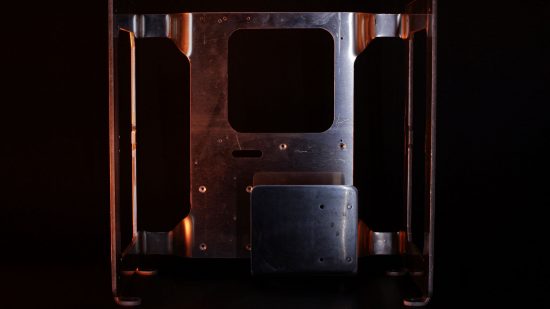
The first few rough sketches of Tilia had a lot more sharp edges. It was very much inspired by a rough, cyberpunk-ish industrial sensibility. I was very hyped for Cyberpunk 2077 at the time and was thinking of leaning heavily into its angular, RGB-lit aesthetic. However, after tinkering with that idea for a bit, I realized this design wouldn’t be timeless. Instead, I needed a design that didn’t hang on a theme.
Eventually, I settled on looking at the works of one of my favorite designers, Dieter Rams. Even if you haven’t heard of him, there’s a high chance you’ve seen his work, or work that was influenced by him.
More specifically, I was very much taken by his Phonosuper – SK4 piece, a radiogramophone that combined the organic warmth of wood and the cold machined look of metal. I especially fell for the straight cut-outs for the sound holes, which are also found in some of his other radios.
With this newfound inspiration, I started rounding the corners of Tilia’s form. At first, I just made the corners less sharp, but eventually I made them completely round. I also added wooden side panels to give the whole piece a feeling of organic warmth.
As the design became more complete I was faced with two problems. The first one was how to anchor the graphics card and the second was how to handle cable management.
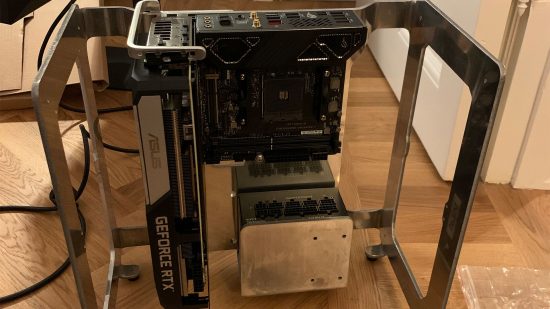
The graphics card was the first problem that I ran into. If the entire case were made by folding a single piece of metal, how and where would the graphics card be mounted? I had variants where the holes for the screws were drilled into the side of the bent metal, but this required the thickness of the metal to be increased to 5mm.
I realized this would be hard to manufacture reliably, and in the end I found that the best solution was to make this one little piece separate and then to manually fasten it to the main body.
After I’d devised that solution, I started fishing for manufacturing help to make the metal body. I didn’t have the workspace, tools or expertise to reliably fold thick metal and I needed help. I had to contact several dozen manufacturers in order to find one that would be able to help me out. The journey of finding the right one also proved helpful, as I was able to fish for information on material choice, tolerances and more, all of which helped to improve the overall design.
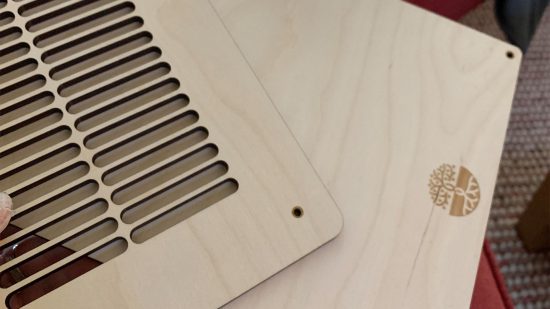
During this process, I continually updated my CAD model with changes to tolerances, while also attempting to tackle that second problem of cable management. The finished case actually has quite a lot of holes in the back, which were intended for various cable management systems.
Unfortunately, one thing I have learned is that 3mm-deep holes don’t leave you much space for screw threads, so they’re mostly unusable. I did, however, manage to fit mounts for two 2.5-inch SSDs in the design, as well as a back cover to hide the holey mess.
Eventually, the design reached a stage where I was happy to send it off to the manufacturer, putting my faith in its ability to build the frame to spec. I didn’t just hurry up and wait though; I started looking into the two steps that would have to follow. First up was finding a facility to help paint the metal frame. Originally I was planning on painting it myself, but after seeing a Cerakoted Ghost S1 on Reddit, and falling down the Cerakote Reddit rabbit hole, I found that I really wanted the same matt ceramic finish.
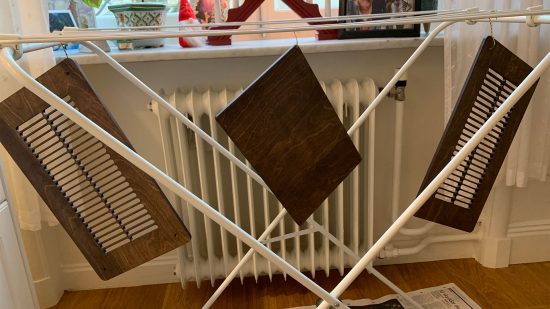
Once again I had put myself in a situation where I couldn’t make it myself, but fortunately there was a place nearby that specialized in Cerakote painting. When the frame was finished, I shipped it over to the people there, and they painted it black. It took a few tries, because for some reason the paint would flare up in patches and not look uniform, but after a few tries an attractive, uniform finish was achieved.
While the frame was being made, I also decided to deal with the wooden panels. Not having much access to any workspace or tools, I decided to have them made for me, and then spent time sanding them to a smooth finish, staining them and then giving them a coat of varnish for protection.
Finally, having all of the pieces ready and assembling the case for the first time was an incredible feeling. The end result far surpassed anything I had hoped to achieve. Now it was just the final stretch of assembling a custom loop, which I’d never done before. Since I didn’t precisely sketch or model my entire loop, I had some close calls, and had to change the pump top, when assembling it. Next time, I’ll model all the fittings to make sure it all will work out before manufacturing.
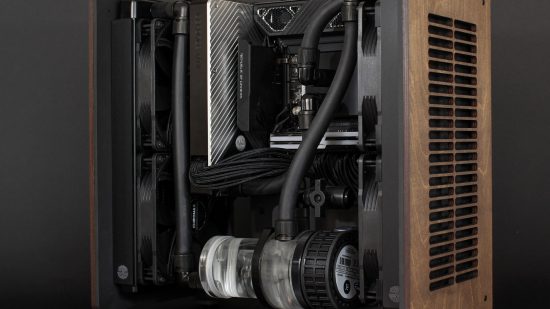
Full bloom
There were tense moments waiting for the air pressure test to complete after assembly, and the first few attempts didn’t pass. It was only after I went over the entire loop twice, securing all the fittings better, that I gave it a pass. Then it was the moment of truth – filling the loop. After some fiddling, it actually went great, and I left it for 24 hours to further leak-test the loop and remove all the air bubbles.
I’m incredibly proud of the end result, and I think it looks great on my desk. It was an experience that I hated at times, and loved at other times. My main disappointment is that I didn’t have access to a proper workshop to do more of the work myself, which I’m looking at rectifying for future projects.
Of course, there are some parts I would like to change with the case itself if I were to make a future revision of it. The first problem that should be addressed is hiding the I/O cables a bit better. In the short term, I’m just buying some 90-degree adaptors to direct them away, but at some point in the future I may have another frame made that rotates the motherboard in a way that can hide them properly.
More realistically, though, I’m going to move on to other projects. In the short term, I’m more interested in looking at how I can modify an existing case rather than building another one from scratch.
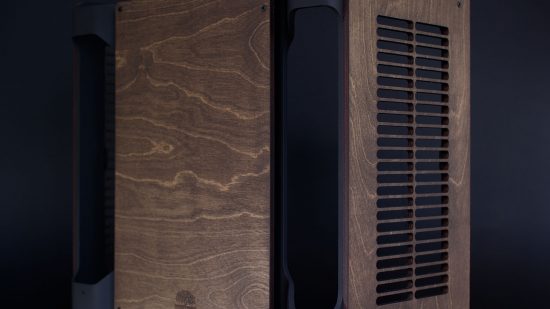
Tilia wood PC specs
- CPU: AMD Ryzen 9 5950X with EKWB EK-Velocity Block
- Graphics card: Nvidia GeForce RTX 3080 Founders Edition with EK-FE waterblock
- Memory: 32GB G.Skill Trident Z 3600MHz
- Motherboard: Asus X570 ROG Crosshair VIII Impact
- Storage: 1TB Samsung 970 Evo Plus, 1TB WD SN750, 2TB Samsung 870 Evo
- PSU: Corsair SF750 with custom cables
- Fans: Noctua NF-A14 PWM
- Pump: EK D5 reservoir combo
- Radiators: 2 x Alphacool ST30 NexXxos 280mm
- Fittings: EKWB models of various kinds
We love the look of this PC – the wood panels really give it a classy appearance, and we’re impressed by the fact that Axel has squeezed a high-spec water-cooled PC into such a small chassis too.
Make sure you read our guide to the best PC builds if you want to see more outstanding custom PCs, and if you’ve built an extraordinary PC of any description yourself, then we’d love to see it! Join our Facebook group, which has over 375,000 members, to submit your own work for consideration.
